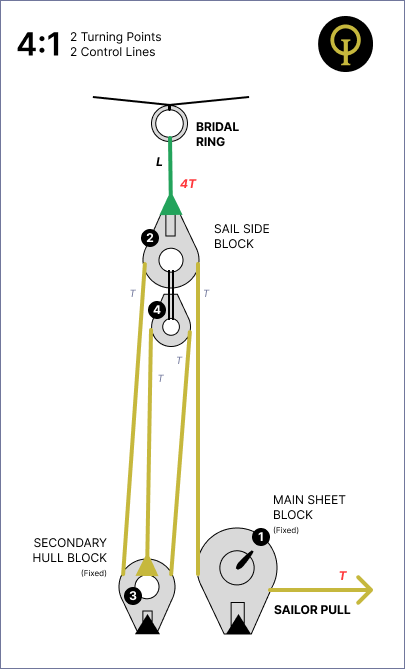A purchase system uses ropes and blocks to reduce the effort required to control a load (T), in this case, the sail, by distributing the force (T) across multiple rope segments using blocks (pulleys). The purchase ratio (mechanical advantage of a pulley system) is the multiplier you get on the force (T) you apply to the system at the load (T). Physically, it comes from the difference between the amount of rope you pull vs. the distance the load moves — for example, an 8:1 system multiplies your pulling force by eight. This means that the load/sail will move one inch for every 8 inches you pull (e.g., 10 lbs of force moves a load of 80 lbs.)
Because the difference between the amount of line you pull and the distance the sail travels can be significant, it’s important to find a good balance between the line pulled and resistance. If everyone were strong enough to pull the Cunningham or Vang in heavy wind, everyone would probably stick to a 4:1 setup. So, make sure to find your own balance. Be ready to use different setups depending on the conditions.
You will find the following terms are frequently used. Here is their definition.
There are a couple of methods to determine the mechanical advantage (MA) of a purchase system: counting rope sections or computing the tension on each rope segment. Personally, I don’t get the rope-counting method. There are too many exceptions, and it never matches my logic. So, I prefer to calculate the tension at each segment. I find it more logical and easier to do. Either way, here is an overview of both.
To determine the purchase ratio of a purchase system using the Active Rope Segments method, you count the number of ‘active’ rope sections between the load (usually the sail) and the force application point (usually the end of the line where the sailor will pull) — essentially, the number of active rope segments (known as "parts") pulling on the sail or load.
For this method, you follow the Load applied by the sailor and how it manifests on each control line segment. In general, all segments have the same Load (T) except those holding a turning point (e.g. a block). In those cases, the block has a line segment going in and another going out, each segment with a load of T. Therefore, the tension at the line holding the block will be 2T. You follow this method until you get to the last rope segment, block, or shackle connected to the sail. Below are a few examples.
On this first example, using Method 1, there are 2 green active segments and 2 yellow active segments, for a 4:1 mechanical advantage (MA). Notice that the sailor pull is not an active segment because it’s not moving along its axis. It changes the line's direction but does not contribute to the mechanical advantage. Using Method 2, this one is simple. The Sail Side Block is holding has two lines of tension, and the Vang Anchor line (in green) acts as another pulley, adding two lines with 2x the tension for a total MA of 4:1. Notice that the green line is moving along its axis with the Sail (load).

In this case, using Method 1, there are 3 green active segments and 3 yellow active segments, for a 6:1 MA. Notice that the sailor pull is not an active segment because it’s not moving along its axis, and neither is the segment between the Mast Block and the Hull Block. Both of those blocks change the direction of the line by 90 degrees, but do not move along their axis; therefore, they do not contribute to the mechanical advantage. Using Method 2, the Fairlead Block is holding 3 lines of tension and passes the tension around the Outhaul Failead, which acts as another block, and into the Clew Block for a 6:1 MA. This is why I like this system, it’s simpler for me to follow.

Using Method 1, there are 4 yellow active segments for a 4:1 MA. Notice that the green lead line is a passive segment and therefore does not count. The same is true for the sailor pull after the main sheet block. It’s a turn only, but it does not contribute to MA. Using Method 2, the green lead line is carrying the full load of the double block, which has 4 segments of tension for a 4:1 advantage in the system. The Secondary Hull block is used to create the additional segments needed to increase the mechanical advantage.
